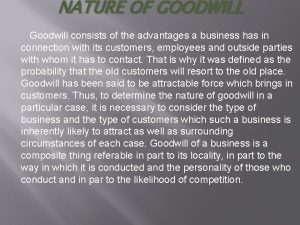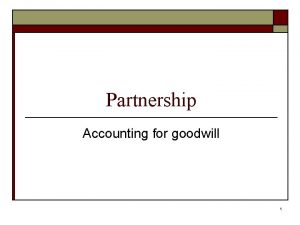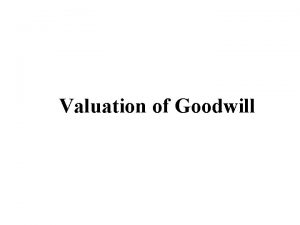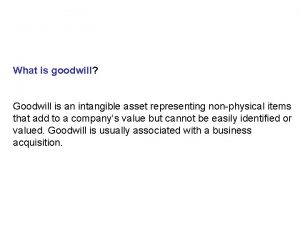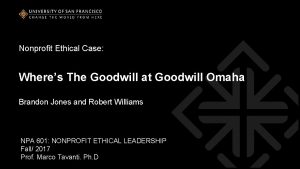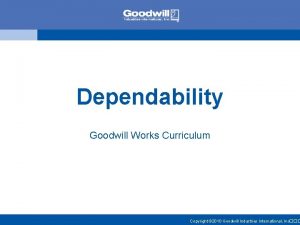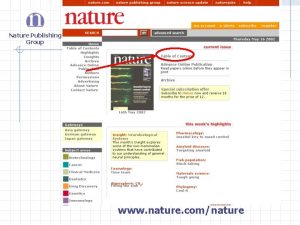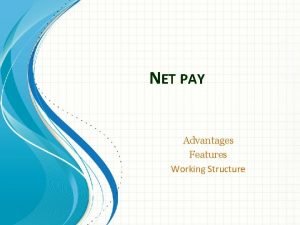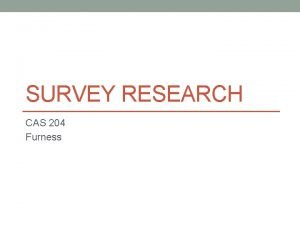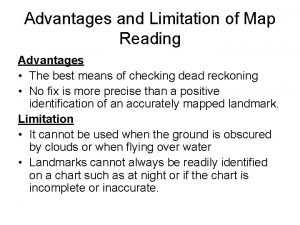NATURE OF GOODWILL Goodwill consists of the advantages






































- Slides: 38

NATURE OF GOODWILL Goodwill consists of the advantages a business has in connection with its customers, employees and outside parties with whom it has to contact. That is why it was defined as the probability that the old customers will resort to the old place. Goodwill has been said to be attractable force which brings in customers. Thus, to determine the nature of goodwill in a particular case, it is necessary to consider the type of business and the type of customers which such a business is inherently likely to attract as well as surrounding circumstances of each case. Goodwill of a business is a composite thing referable in part to its locality, in part to the way in which it is conducted and the personality of those who conduct and in par to the likelihood of competition.

Goodwill is sometimes described as a ‘momentum or a push’ that keeps the business going without further effort like the momentum of a body that continues its motion against a retarding force till it comes to rest gradually. when a man pays for goodwill, he pays for something which places him in the position of being able to earn more than he would be able to do by his own unaided efforts. Goodwill is, thus, present value of a firm’s anticipated super normal earnings. The term ‘super normal earnings’, means the excess of earnings attributable to operating tangible and intangible assets (other than goodwill) over and above the normal rate of return earned by representative firms in the same industry. It is the extra saleable value attaching to a prosperous business beyond the intrinsic value of net asset. According Kohler “goodwill is the current value of expected future income in excess of a normal return on investment in net tangible assets. ”

According to Hendriksen. “If the expected future earnings are less than a satisfactory return, the capitalisation of this deficiency is sometimes thought of as negative goodwill” As per statement of standard accounting practices (SSAP)-22, goodwill is the difference between the value of a business as a whole and the aggregate of the fair value of its separable net assets. Separable net assets are those assets (and liabilities) which can be identified and sold (or discharged) separately without necessary disposition of the business as a whole. They include identifiable intangibles. Fair value is the amount for which the asset (or liability) would be exchanged in an arm’s length transaction. Thus the value of the business as a whole may differ from the value of its separate net assets. The difference may be positive or negative and is described as goodwill. Goodwill has the characteristics of cement. According to A. V. Adamson, “just as cement binds together the bricks and other building material into walls, similarity goodwill binds together or unites the other assets and aspects of the business into cohesive whole. ’’ Whatever may be the nature of goodwill, one thing is definite about it. It is treated as an intangible asset in accounts. One of the basic characteristic features of assets is that they help in earning profit for the business. As a result, every asset is said to have productivity. Thus, goodwill is, like any other asset, a store of prospective revenue.

FEATURES OF GOODWILL Following are the special features of goodwill: 1. 2. 3. 4. 5. Goodwill can be sold only with the entire business or it cannot be sold in part or in isolation except on admission or retirement of a partner when new partner compensate the old partners or the retiring partner gibes up his rights in favor of remaining partners. Goodwill is valuable only if it is capable of being transferred from one person to another. If it cannot be transferred then there will be no value of goodwill. Goodwill represents a non-physical value over and above the physical assets. Goodwill cannot have an exact cost as its value fluctuates from time to time due to internal or external factors which ultimately affect the fortune of the company. The value of goodwill is based on subjective judgment of the value.

TYPES OF GOODWILL The goodwill is generally of two types i. e. , purchased goodwill or non-purchased (raised) goodwill. Purchased goodwill arises only when a business enterprise is acquired by another business enterprise and the price paid is more than the net assets acquired such goodwill is recognised by the accounting profession and is also shown in the balance sheet. The main features of such goodwill are- (i) it arises only on purchase of business (ii) it is reflected by a purchase transaction (iii) its cost could depend upon the future maintainable profits (iv) it can be shown in the balance sheet. Factors like marked reputation, economies of scale, fiscal advantages etc. contribute towards the value of goodwill.

Non-purchased (or raised or inherited) goodwill arises only when a business generates its own goodwill over a period of time due to various factors such as location, good management, good quality products, sales policies, good public image etc. generally contribute towards the development of this type of goodwill. The main features of such goodwill are: (i) its is internally generated, (ii) no cost can be placed on it, (iii) value of goodwill is based on the subjective judgement of the valuer, (iv) it is not reflected by a purchase consideration, and (v) it is not shown in the balance sheet. Goodwill and depreciation Depreciation is always charged on fixed assets. Goodwill being of the intangible assets category does not suffer wear and tear and , thus, there is no depreciation on goodwill. Goodwill is liable to constant fluctuations. It is invisible, it does not become absolute and does not get used up in the course of business operations. Goodwill is amortised. It is always present as a silent asset in a business when there are super profits but declines in value co-extensively with decline in earnings.

CLASSES OF GOODWILL According to Rowland, “ there are four principal classes of goodwill, viz. , 1. Local, arising from the situation of the trader’s premises, e. g. , a retail shopkeeper in a busy market centre; 2. The personal reputation of the individual, arising through his skill, influence and personality, as in the case of a professional man, e. g. , an accountant or a doctor; 3. The reputation of the goods sold, arising from the high standard of quality of the goods sold themselves, e. g. , a well-advertised brand of proprietary goods; 4. The absence of competition, or the existence of an absolute or partial monopoly.

RECORDING OF GOODWILL Goodwill is the most unrealisable form of assets as it can be disposed of only in the event of the business being sold as a going concern, so goodwill should not be recorded unless it is necessary to do so. According to Braden and Allyn “Even though management believes and has evidence to prove that its earnings are above normal in its industry, goodwill should not be recorded until a buyer, in an arm’s length transaction, pays more for a business than is warranted by the book value of its assets. Even this difference may assets at their market values instead of their book values. : goodwill should be recorded at cost when it has been acquired.

Following are the circumstances when goodwill is valued and recorded: 1. In case of partnership where there is a change in the profit sharing ratio on admission, death and retirement of a partner or when two firms are amalgamated, the value of goodwill is to be calculated. 2. In case of joint stock company, the need for valuation of goodwill may arise in the following cases: (a) when the business of the company is to be sold to another company or when the company is to be amalgamated with another company. (b) when the stock exchange quotations not being available, share have to be valued for taxation purposes-gift tax etc. (c) when a large block of shares has to be bought and sold so as to enable the buyer to exercise control over the company concerned. (d) when the company is being taken over by another company. (f) Where a person or a company desires to purchase another business, the vendor will generally require his accountant to investigate the value so declared to be attached to the goodwill. (g) goodwill is frequently to be brought into account upon consolidation of the assets and liabilities of a holding company and its subsidiaries.

FACTORS TO BE CONSIDERED IN VALUATION OF GOODWILL 1. The following factors requires emphasis: The earning capacity of the business: A Person buying a business is vitally concerned with the question as to whether it will maintain its profit in future. The earning capacity of the business depends upon the following factors: (a) nature of goods (b) Monopolized business (c) Risk involved (d) Trade name (e) Favorable location and site

(f) Possession of Trademarks, Patents and Copyrights. (g) Access to supplies. (h) Skill of management. (i) Possession of exceptional contracts. (j) Future competition. (k) Money market conditions. (l) Stable political condition. (m) Government industrial policies. (n) Profit trends (o) Capital required.

METHODS OF VALUING GOODWILL 1. ARBITRARY ASSESSMENT: The valuation of goodwill is arrived at by making a valuation by one of the parties. i. e. vender or purchaser to which the other agrees. The parties may together estimate the value to be placed on the goodwill or an independent party may be called in to give his opinion as to the value , it being left to the parties to decide whether they will accept or reject the valuation. This method can be used only when information regarding earning capacity is available. If the information is not available because of nonavailablity of the profit immediately prior to the sale or if the profit are abnormal or unreliable then such profit cannot be used as a guide to future profits.

CAPITALISATION OF EXPECTED FUTURE NET PROFITS Following are the main steps to be taken in computing goodwill by this method: (a). Ascertain the average net profit which it is expected will be earned in future. (b). Capitalize this net profit at the rate which is concerned a suitable return on capital invested in a business of the type under consideration (c). Find the value of the net tangible assets used in the business i. e. , assets less outside liabilities and (d) Deduct the net tangible assets as per from the capitalization profit obtained in and the difference is goodwill. �

The future maintainable profit needs elaboration. While making an estimate of future maintainable profit on the basis of past profits, the following points are to be taken into consideration (1) all unusual working expenses should be excluded. Interest on debenture and deprecation on all fixed assets should be excluded. (2). Non trading assets such as non trading investments should be excluded from the capital employed and income derived from such assists should also be excluded from profits. (3). all necessary provisions for liabilities such as provision for taxation should be made. (4). Preference dividend should be deducted. �

(5). While calculating averages profits, profits for the past four or five years during which conditions have remained normal should be considered. (6). Effects of developments which have already taken place but whose results are likely to come in the future should be considered.

Illustration : A company desirous of selling its business to another company has earned an Average profit in the past of Rs 1, 50, 000 p. a. It is consider that such Average fairly represents the profit likely to be earned, in the future , expected that : (a) Directors’ fees Rs 10000 charged again such profit will not be payable by the purchasing company whose existing board can easily cope with the additional administrative work at present fees payable to the directors. (b) Rent at Rs 20000 p. a which had been paid by the vendor company will not be a charge in the future, since the purchasing company owns its own premises and can supply the accommodation necessary for the staff and the equipment of the vendor company.

Conti…. . The value of the Net tangible assets of the vendor company at the proposed date of sale was Rs 1500000 and it was considered that a reasonable return on capital invested, for this type of commodity, was 10%. The profit of the vendor company would in now way be affected by the sale of its business of the purchasing and goodwill existed and was to be paid for on the basis that the vendor company was a continuing enterprise. Calculate the value of goodwill by capitalization of expected future net profits.

CALCULATION OF THE VALUE OF GOODWILL SOLUTIO N Average net profit Add: Non recurring charges for: Rs Directors fees 10000 Rent 20000 Estimate future maintainable profit Future profit capitalized at 10%i. e 180000 x 100 10 1, 50, 000 30, 000 1, 80, 000 18, 00, 000 15, 00 0 3, 000

Purchase of past average profits � � � This method of valuing goodwill is commonly met with in practice and probably is the one most generally understood. It is calculated on the following basis: ( 1) profit for an agreed number of years preceding valuation are averaged so as to arrive at the average annual profit earned during that period. Average used may be simple or weighted. (2) the goodwill is then estimated to be worth so many years’ purchase of such average profit. The number of years selected is presumed to bear relation to the number of years benefit to be derived from past association

� The value of goodwill is calculated by multiplying the adjusted annual profits by the number of years of purchase.

Step 1: Calculation of adjusted profits. While calculating adjusted profits, the profits of each year should be adjusted in the light of future probabilities. The following Performa will help to calculate adjusted future profits PROFITS Add: 1. all expenses and losses not likely to occur or incur in future as extraordinary salary of a person , loss from fire or theft(i. e. abnormal losses) 2. All profits likely to come in the future as profits due to new line of business. xx xx xx LESS: 1. All expenses and losses expected o occur in future as salary of directors and staff to be appointed , insurance of stock in future , deprecation in future, cost of management or any expenses not provided earlier but to be incurred in future. 2. Profit not likely to recur Adjusted (future) profits xx xx

Step 2. Calculation of Adjusted Average Profit After computation the adjusted profits , it is necessary to find out the adjusted average profit. This can be ascertained by simple or weighted Average Profit method. � Simple average profits method is applied when there is fluctuation in profits and can be calculated by using the following formula: Adjusted Average Profits (Simple Average)= Total Adjusted Profit of all the given years No. of years �

� � � 1. 2. Weighted Average Profit Method is used when either weights for each year are given or when the profits are following an increasing or decreasing trend. This can be calculated by using the following formula: Weighted Adjusted Average Profits = Total profit Total weights Note: when weights are not given, then arbitrarily weights can be assigned as under: For the first year For the second year and so on with the highest weight to the recent most year.

STEP-3 Calculation of Goodwill The value of goodwill can be calculated using the following formula: Value of goodwill= Adjusted Average Profit x No. of Years of purchase NOTE: when the no. of years of purchase is not given , then number of years for which profit or loss details are given should be taken. �

� � Illustration : Hitesh & Co. decided to purchase a business. The profits for the last four years are : 2008 -Rs 60, 000 2009 -75, 000 , 2010 -Rs 72, 000, and 2011 -Rs 69, 000. the business was looked after by the management. Remuneration from alternative employment if not engaged on the business comes to Rs 9000 p. a. Find the amount of Goodwill, if it is valued on the basis of 3 year purchase of average net profit for the last 4 year.

� � Solution: 1. Calculation of average profit 2008 Rs Rs Profits 69000 Less : Remuneration for management 60000 2009 Rs 2010 2011 Rs 75000 72000 9000 9, 000 51000 66000 63000 60000 Total adjusted profit for four years = 2, 40, 000 2. Calculation of adjusted Average Profit = Total Adjusted profits for four years = 60, 000 No. of years 3. Calculation of goodwill Rs, 2, 40, 000 4 = Rs

SUPER PROFITS OR EARNING

SUPER PROFITS It is the excess of the average profits over the normal profits based on normal rate of return for representative firm in the industry. � There are three factors for computation of super profit : 1). NORMAL RATE OF RETURN This is the rate of profit or return which an investor expects on his investment in a particular type of industry. It may be the aggregate of pure rat of return and risk rate of return. �

2). CAPITAL EMPLOYED : � It may be calculated on the basis of asset side items or liabilities side items. � PROCEEDING FROM ASSETS SIDE: Capital Employed= Fixed assets+ trade investments +Current assets. Debentures -Current liabilities � PROCEEDING FROM LIABILITIES SIDE: Capital Employed= Paid-up equity & Preference share capital + Accumulated balance in capital reserve , General reserve and Credit Balance in profit and loss. Fictitious assets-Non trading assets �

Average capital employed =1/2(Capital Employed at the beginning + Capital Employed at the end of year) � 3). NORMAL PROFIT: It is calculated by multiplying the normal rate of return with capital employed or average capital employed as the case may be. Super Profit method has three variation a) Purchase of Super Profit b) Capitalization of super profit c) Annuity method

� NORMAL PROFIT PURCHASE OF SUPER PROFIT ANNUITY METHOD CAPITALISATION OF SUPER PROFIT

PURCHASE OF SUPER PROFITS � a) b) In the method of valuing goodwill, attention is focused upon super profit which are those profits remaining after deduction from the estimated annual future profit: Reasonable remuneration of proprietors and management. An amount considered to be a reasonable return on the amount of capital invested in the tangible assets.

Q. . (PURCHASE OF SUPER PROFIT) � The average net profit (before adjustment ) is Rs. 514000. The profit includes interest at 8% on non-trading investment. The cost of these investment is Rs 198200, while their face value is Rs 200000. Expenses amounting to Rs 7000 per annum are likely to be discounted in future. The provision for income tax may be made at 50%. The normal rate of return is taken at 10%. The average capital employed in the business (including investment) is Rs 1898200.

SOLUTION � � � � Average net profit (before adjustment) = 5, 14, 000 Less: interest @8% on non –trading investment = 16, 000 4, 98, 000 Add: Expense to discontinue in future 7, 000 5, 50, 000 Less: Income tax (50%) 2, 25, 500 Future maintainable profit 2, 500 Average capital employed (as given) 18, 98, 200 Less: Cost of non-trading assets 1, 98, 200 Average Capital Employed 17, 000 Normal profit @10% on Rs 17, 000 = 1, 70, 000 Super profit (i. e. Rs 2, 500 –Rs 1, 70, 000) = 82, 500 Value of goodwill =Super profit x No. of year purchase

CAPITALISATION OF SUPER PROFIT � Under this method the value of goodwill is calculated by capitalizing the super profit at the normal rate of return. This method attempts to determine the amount of capital needed for earning super profit. The value of goodwill is calculated by the following formula: Average Annual Super Profit x 100 Normal Rate Of Return

� Suppose the super profit is Rs 45000, the normal rate of profit is 15%, the value of goodwill as per capitalization of super profit method is : Rs 45000 15% = Rs 3, 000

ANNUITY METHOD � This method is similar to that of super profit method except that super profit when arrived at is not multiplied by a figure representing a certain number of years’ purchase of such super profits. The value of goodwill is calculated by finding the present worth of an annuity paying the super profit (per year) over the estimated period discounted at the appropriate rate of interest.

We have to ascertain the amount of cash it is necessary to pay out now in order: (a) To obtain the right to receive the amount of super profit annually for the estimated number of future years, (b) To allow for the fact that the money would earn its appropriate rate of interest if invested. FORMULA: � Q = the present value of an annuity r = the rate % per annum n = the number of years
 Advantages of goodwill
Advantages of goodwill Nature and nature's law lay hid in night meaning
Nature and nature's law lay hid in night meaning Nature nature controversy
Nature nature controversy Hình ảnh bộ gõ cơ thể búng tay
Hình ảnh bộ gõ cơ thể búng tay Ng-html
Ng-html Bổ thể
Bổ thể Tỉ lệ cơ thể trẻ em
Tỉ lệ cơ thể trẻ em Voi kéo gỗ như thế nào
Voi kéo gỗ như thế nào Chụp phim tư thế worms-breton
Chụp phim tư thế worms-breton Chúa yêu trần thế alleluia
Chúa yêu trần thế alleluia Các môn thể thao bắt đầu bằng tiếng nhảy
Các môn thể thao bắt đầu bằng tiếng nhảy Thế nào là hệ số cao nhất
Thế nào là hệ số cao nhất Các châu lục và đại dương trên thế giới
Các châu lục và đại dương trên thế giới Công thức tính thế năng
Công thức tính thế năng Trời xanh đây là của chúng ta thể thơ
Trời xanh đây là của chúng ta thể thơ Cách giải mật thư tọa độ
Cách giải mật thư tọa độ Phép trừ bù
Phép trừ bù độ dài liên kết
độ dài liên kết Các châu lục và đại dương trên thế giới
Các châu lục và đại dương trên thế giới Thơ thất ngôn tứ tuyệt đường luật
Thơ thất ngôn tứ tuyệt đường luật Quá trình desamine hóa có thể tạo ra
Quá trình desamine hóa có thể tạo ra Một số thể thơ truyền thống
Một số thể thơ truyền thống Cái miệng bé xinh thế chỉ nói điều hay thôi
Cái miệng bé xinh thế chỉ nói điều hay thôi Vẽ hình chiếu vuông góc của vật thể sau
Vẽ hình chiếu vuông góc của vật thể sau Nguyên nhân của sự mỏi cơ sinh 8
Nguyên nhân của sự mỏi cơ sinh 8 đặc điểm cơ thể của người tối cổ
đặc điểm cơ thể của người tối cổ Ví dụ giọng cùng tên
Ví dụ giọng cùng tên Vẽ hình chiếu đứng bằng cạnh của vật thể
Vẽ hình chiếu đứng bằng cạnh của vật thể Vẽ hình chiếu vuông góc của vật thể sau
Vẽ hình chiếu vuông góc của vật thể sau Thẻ vin
Thẻ vin đại từ thay thế
đại từ thay thế điện thế nghỉ
điện thế nghỉ Tư thế ngồi viết
Tư thế ngồi viết Diễn thế sinh thái là
Diễn thế sinh thái là Dạng đột biến một nhiễm là
Dạng đột biến một nhiễm là Số nguyên tố là số gì
Số nguyên tố là số gì Tư thế ngồi viết
Tư thế ngồi viết Lời thề hippocrates
Lời thề hippocrates Thiếu nhi thế giới liên hoan
Thiếu nhi thế giới liên hoan
